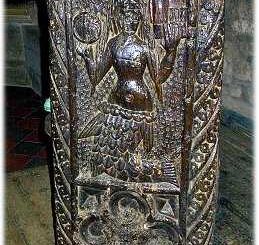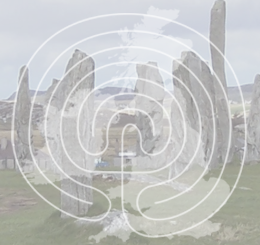River Monnow Bridge, Kentchurch
In ‘The Folk-Lore of Herefordshire’ (1912), Ella Mary Leather gave the following account of a bridge associated with the Devil. This bridge crosses the River Monnow which separates Gwent from Herefordshire.
 ‘Jack o’ Kent (also known as Siôn Cent, Sion Gwent, Jacky Kent, Jack of Kent, Sion Y Kent, Rev John Kent or John of Kent) and the devil built the bridge over the Monnow between Kentchurch and Grosmont in a single night. What they built by night fell down by day as long as the bridge remained incomplete, hence the need for haste. The first passenger to pass over the bridge was to belong to the devil, so Jack threw a bone across, and a poor dog ran after it. That dog was all the devil had for his pains.’
‘Jack o’ Kent (also known as Siôn Cent, Sion Gwent, Jacky Kent, Jack of Kent, Sion Y Kent, Rev John Kent or John of Kent) and the devil built the bridge over the Monnow between Kentchurch and Grosmont in a single night. What they built by night fell down by day as long as the bridge remained incomplete, hence the need for haste. The first passenger to pass over the bridge was to belong to the devil, so Jack threw a bone across, and a poor dog ran after it. That dog was all the devil had for his pains.’




Re: River Monnow Bridge, Kentchurch
British Goblins (1881) by Wirt Sykes:
Tradition relates that Sion Cent was a famous necromancer in Monmouthshire, who outwitted the devil, not once but many times. He lives in popular legend simply as a worker in magic, but in reality he was a worthy minister, the Rev. John Kent, who flourished from 1420 to 1470, and wrote several theological works in Latin. In his native Welsh he confined himself to poetry, and Sion Cent was his Cymric pseudonym. Like many learned men in those days, he was accredited with magical powers by the ignorant peasantry, and of his transactions with the devil many stories were then invented which still survive. One relates that he once served as a farmer’s boy, and was set to keep the crows from the corn, but preferring to go to Grosmont fair, he confined the crows in an old roofless barn by a magic spell till the next day, when he returned. His compact with the devil enabled him to build the bridge over the Monnow, near Grosmont, which still bears his name. The compact gave the devil the man’s soul, as all such compacts do — the stipulation being that if his body were buried either in or out of the church, his soul should be forfeit to the diawl. But the shrewd Welshman gave orders that he should be buried exactly under the chancel wall, so that he should lie neither in the church nor out of it; and the devil was made a fool of by this device. A precisely similar tradition exists concerning an old gentleman in Carmarthenshire.